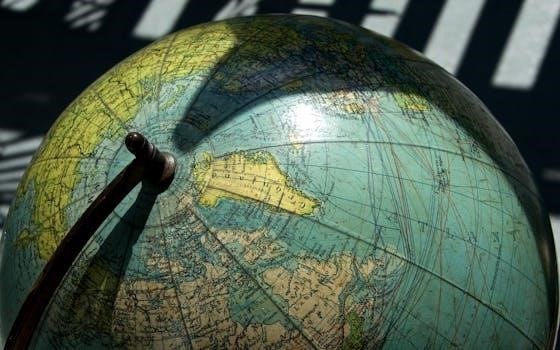
World History Study Guide⁚ A Comprehensive Plan
This guide offers a structured approach to world history, encompassing various periods and themes. It includes course materials, additional resources, and a framework for understanding major historical developments. The guide is designed to aid both students and educators in navigating the complexities of world history.
Course Materials Overview
The core course package includes “World History⁚ Communities and Connections” coursebook, along with “Worlds Together, Worlds Apart.” Furthermore, students will utilize “Documents in World History,” volumes 1 and 2. These materials provide a comprehensive foundation for the course. It is recommended that students obtain supplementary books such as “History of the World, Map by Map” and the “World History⁚ Communities and Connections” Teacher Edition, to further enhance their learning experience. In addition to these, students will need to secure a primary source book and access a comprehensive list of links to history resources, archives, and teaching ideas, categorized by historical period. The goal of these materials is to provide a complete resource for studying world history.
Recommended Additional Resources
To deepen your understanding of world history, several supplemental resources are highly recommended. “History of the World, Map by Map” offers a geographical perspective, enriching your comprehension of historical events; The “World History⁚ Communities and Connections” Teacher Edition provides valuable insights and pedagogical approaches. For project work, a book-length primary source is essential, allowing for in-depth analysis of historical documents. A comprehensive, annotated list of links to history resources, archives, and teaching ideas, categorized by time period, will also prove invaluable. Consider exploring the Khan Academy World History for a broader overview, with a European focus. These resources are designed to complement the course materials and enhance your learning experience, providing various perspectives and tools for thorough study.
Key Historical Periods and Big Eras
World history is often categorized into significant periods and “Big Eras,” each characterized by distinct trends and developments. The course will explore six historical periods from approximately 8000 B.C.E. to the present, encompassing major transformations in human societies. Additionally, it delves into the nine “Big Eras” of world history, offering a broad chronological framework for understanding global changes. These eras address large-scale developments, providing a panoramic view of history. Each “Big Era” includes a PowerPoint Overview Presentation, enhancing visual learning and comprehension. Understanding these key periods and eras is essential for grasping the overarching narrative of world history. The study of these periods will highlight the interconnectedness and evolution of global societies.
AP World History Course Framework
The AP World History course framework is designed to provide a comprehensive and structured approach to learning world history. It outlines the curricular components, including the sequence of units, their weighting, and suggested pacing. The framework emphasizes the progression of topics within each unit and the spiraling of themes and historical thinking skills. The pacing is based on 45-minute class periods, meeting five days a week for a full academic year. The framework also incorporates the AP History Disciplinary Practices and Reasoning Skills, focusing on how students should think and act like historians. It is organized into nine commonly taught units, offering a possible sequence for the course. The framework encourages flexibility in organizing course content, allowing educators to adapt the material to their specific needs and contexts. Ultimately, it aims to foster a deeper understanding of world history.
AP World History Exam Structure

The AP World History exam is a comprehensive assessment designed to measure students’ knowledge of world history and their ability to think historically. The exam is 3 hours and 15 minutes long and includes a variety of question types. The questions are based on learning objectives, key concepts, course themes, and the AP history disciplinary practices and reasoning skills. The exam assesses students’ abilities to analyze historical sources, make connections, and craft historical arguments. It is structured to evaluate not only the recall of factual information but also the application of historical analysis skills. The exam is a crucial component of the AP World History course, reflecting the depth and breadth of the curriculum. It aims to determine if a student has developed the skills and understanding equivalent to a two-semester introductory college world history course. Success on the exam often translates to college credit.
World History II Curriculum Overview
World History II is a continuation of World History I, designed to highlight the interaction and interdependence of people in our increasingly interconnected world. This course typically begins with the Scientific Revolution and progresses through modern times, focusing on how global interactions have shaped societies. Students will analyze historical events, focusing on themes such as cultural exchange, political developments, and economic systems, and the impact of technology. The curriculum explores how different societies have responded to similar challenges, and fosters an understanding of the complex relationships between regions and nations. The course emphasizes critical thinking, the ability to analyze primary sources, and the development of historical arguments. It provides students with a deeper understanding of the forces that have shaped the world today, and promotes an appreciation of diverse perspectives and cultures. The course also encourages students to examine the ongoing relevance of historical events.
Curriculum for Multiple Ages and Families
A world history curriculum designed for multiple ages and families emphasizes flexibility and adaptability, catering to diverse learning styles and levels. Such curricula often incorporate a variety of resources, including primary source documents, engaging narratives, and hands-on activities. The aim is to create a learning environment where all family members can explore the past together, regardless of their individual ages or academic backgrounds. These curricula often utilize a thematic approach, allowing for the study of global history through the lens of shared human experiences, rather than strictly chronological order. This approach encourages collaborative learning and discussion, fostering critical thinking skills for all. Families might use a combination of textbooks, online resources, and interactive projects, adjusting the complexity of the materials to suit the needs of each student. By making history accessible and engaging, these curricula encourage a lifelong love of learning for the entire family.

AP History Disciplinary Practices
AP History disciplinary practices emphasize the skills historians use to analyze the past. These practices are crucial for understanding historical events and developing well-supported arguments. Students learn to identify and explain historical developments and processes, moving beyond simple memorization to deep comprehension. Analyzing sourcing and the situation of primary and secondary sources is essential, allowing students to evaluate the context and reliability of historical materials. Constructing arguments based on historical evidence is a core skill, teaching students to create logical and persuasive claims. Analyzing the contexts of historical events, developments, and processes helps students grasp the complexities of the past. Furthermore, students practice using historical reasoning processes like comparison, causation, and continuity and change to analyze patterns and connections. These practices enable students to think like historians, developing critical analysis and argumentation skills vital for academic and professional success. The goal is to equip students with the ability to engage with history thoughtfully and critically.
Thematic Learning Objectives in AP World History
Thematic learning objectives in AP World History focus on overarching themes that connect historical events across different time periods and regions. These themes provide a framework for analyzing the past, moving beyond a simple chronological narrative. One significant theme is the interaction between humans and the environment, exploring how societies have shaped and been shaped by their surroundings. Another theme centers on cultural developments and interactions, examining the exchange of ideas, beliefs, and artistic expressions. Governance is a key theme, addressing the forms of political organization and power structures throughout history. Economic systems are also examined, analyzing the production, distribution, and consumption of goods and services. Social interactions and organization is another important theme, exploring how societies are structured and how individuals relate to one another. Finally, technology and innovation are considered, highlighting the impact of new tools and techniques on human life. These themes help students make connections and develop a more nuanced understanding of the past.
AP World History Units of Study
The AP World History course is structured into nine units, providing a comprehensive overview of global history. These units are designed to be taught sequentially, but with some flexibility for teachers. Unit 1 typically covers the Global Tapestry from c. 1200 to c. 1450, examining the emergence and interactions of states and empires. Unit 2 explores Networks of Exchange from c. 1200 to c. 1450, focusing on trade, cultural exchange, and technological diffusion. Unit 3 delves into Land-Based Empires from c. 1450 to c. 1750, analyzing the growth and administration of large empires; Unit 4 examines Transoceanic Interconnections from c. 1450 to c. 1750, covering exploration, colonization, and the Columbian Exchange. Unit 5 focuses on Revolutions from c. 1750 to c. 1900, exploring political, social, and industrial transformations. Unit 6 details Consequences of Industrialization from c. 1750 to c. 1900, analyzing the impact of industrialization on societies. Unit 7 covers Global Conflict from c. 1900 to the present, examining world wars and other conflicts. Unit 8 explores Cold War and Decolonization from c. 1900 to the present, analyzing the geopolitical tensions and independence movements. Finally, Unit 9 examines Globalization from c. 1900 to the present, looking at the interconnectedness of the modern world. These units provide a structured way to explore world history.
Skills for Historical Analysis
Developing strong historical analysis skills is crucial for understanding world history. One essential skill involves identifying and explaining historical developments and processes, requiring students to recognize patterns and changes over time. Another vital skill is analyzing the sourcing and situation of primary and secondary sources, understanding the author’s perspective and context. Furthermore, students must analyze arguments presented in both primary and secondary sources, evaluating the validity of claims and evidence. Analyzing the contexts of historical events, developments, and processes is also necessary, understanding the social, political, and economic factors at play. Crucially, students need to use historical reasoning processes such as comparison, causation, and continuity and change, which allows them to analyze patterns and connections. These skills enable students to move beyond memorization and engage with historical events on a deeper level, fostering a more comprehensive understanding of world history and its complexities. The ability to think critically about the past is fundamental to historical analysis.
World History Curriculum Units
A comprehensive world history curriculum is typically organized into distinct units, each focusing on specific periods or themes. These units often cover a chronological progression, starting from ancient civilizations and moving towards the modern world. For example, one unit might explore ancient civilizations, while another might focus on the medieval period. The curriculum also includes units dedicated to the Renaissance, the Age of Exploration, the Scientific Revolution, and the Enlightenment. Later units may delve into the Industrial Revolution, imperialism, and the two World Wars. Contemporary units often address the Cold War, decolonization, and the challenges of the 21st century. Each unit incorporates diverse historical sources, encouraging students to analyze events from multiple perspectives. These units are designed to be flexible, allowing educators to adapt the content and pacing to their specific needs. A well-structured curriculum ensures students gain a broad understanding of world history.
Cultural Components in World History
Understanding cultural components is essential to grasping world history. These components encompass a wide array of aspects, including art, literature, music, religion, and philosophy. Cultural developments often reflect the values, beliefs, and social structures of societies at different times. Examining these elements helps students understand the diversity of human experience and the ways in which cultures have interacted and influenced each other. For instance, studying religious texts or artistic expressions can provide insight into the worldview of a particular civilization. Exploring the evolution of philosophical thought reveals how societies have grappled with fundamental questions about life and existence. Moreover, analyzing cultural exchanges highlights the impact of trade, migration, and conquest on the diffusion of ideas and practices. A comprehensive study of world history must therefore integrate an analysis of cultural components to provide a holistic understanding of the past.
